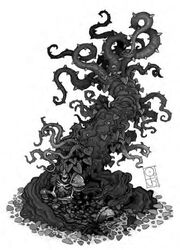CowerFool11094@legacy41532184 (talk | contribs) No edit summary |
mNo edit summary |
||
| (18 intermediate revisions by 12 users not shown) | |||
| Line 1: | Line 1: | ||
| + | [[Image:Strangletthornplant.JPG|thumb]] |
||
| ⚫ | |||
| + | |||
| + | Man-eating '''stranglethorn''' vines derive their name from their native environment: the dangerous, mist-filled jungles of [[Stranglethorn Vale]]. |
||
| + | |||
| + | Stranglethorn vines are a crucial part of the jungle ecosystem, acting as a counterweight to some of the region's larger predators. Blending in with other types of less-dangerous flora, they often lay in wait, concealed for several days, until prey approaches into range. |
||
| + | |||
| + | The plant consists mostly of large, trunk-like stalks covered in semi-translucent bark. Its entire length is dotted with numerous clusters of leafy, thorn-covered vines that almost manage to conceal a pattern of strange, swollen bulges protruding from various places along the main stalk. |
||
| + | |||
| + | Possessing a rudimentary digestive system, stranglethorn vines can extract nutrients only from the easily digestible outer layers of fleshy creatures. After food is stripped of nutritional value, it is expelled from the trunk and discarded at the plant's base. |
||
| + | |||
| + | Inedible materials such as beetles, insects, and skeletons are completely ignored by the plant. [[Carrion Beetle]]s often form a symbiotic relationship with the plant, living in burrows at the vine's base. There, they help break down the remains of the plant's victims and lay eggs in the decomposing corpses. In turn, carrion beetles are considered food by other predators, and serve as lures to draw additional prey within the vine's reach. |
||
| + | |||
| + | A stranglethorn attacks with its vine-like tendrils when prey strays within reach. It uses paralytic poison which subdues its prey, making it easier to pull towards its trunk. The prey is then encased over the next hour in a bark-like shell over as the main trunk grows around it. The outline of the victim is usually visible for several days afterwards. Once the creature is digested within the main trunk, a split forms and indigestibles are expelled. The split closes back up, leaving the stranglethorn's treasure buried under a thin layer of dead leaves and organic debris at the base of the main trunk.<ref>''[[Lands of Conflict]]'', pg. ??</ref> |
||
| + | |||
| + | == References == |
||
| + | {{reflist}} |
||
| + | |||
| ⚫ | |||
| + | [[Category:Plants]] |
||
| + | [[Category:Lands of Conflict]] |
||
Revision as of 16:47, 15 June 2010

Man-eating stranglethorn vines derive their name from their native environment: the dangerous, mist-filled jungles of Stranglethorn Vale.
Stranglethorn vines are a crucial part of the jungle ecosystem, acting as a counterweight to some of the region's larger predators. Blending in with other types of less-dangerous flora, they often lay in wait, concealed for several days, until prey approaches into range.
The plant consists mostly of large, trunk-like stalks covered in semi-translucent bark. Its entire length is dotted with numerous clusters of leafy, thorn-covered vines that almost manage to conceal a pattern of strange, swollen bulges protruding from various places along the main stalk.
Possessing a rudimentary digestive system, stranglethorn vines can extract nutrients only from the easily digestible outer layers of fleshy creatures. After food is stripped of nutritional value, it is expelled from the trunk and discarded at the plant's base.
Inedible materials such as beetles, insects, and skeletons are completely ignored by the plant. Carrion Beetles often form a symbiotic relationship with the plant, living in burrows at the vine's base. There, they help break down the remains of the plant's victims and lay eggs in the decomposing corpses. In turn, carrion beetles are considered food by other predators, and serve as lures to draw additional prey within the vine's reach.
A stranglethorn attacks with its vine-like tendrils when prey strays within reach. It uses paralytic poison which subdues its prey, making it easier to pull towards its trunk. The prey is then encased over the next hour in a bark-like shell over as the main trunk grows around it. The outline of the victim is usually visible for several days afterwards. Once the creature is digested within the main trunk, a split forms and indigestibles are expelled. The split closes back up, leaving the stranglethorn's treasure buried under a thin layer of dead leaves and organic debris at the base of the main trunk.[1]
References
- ^ Lands of Conflict, pg. ??
